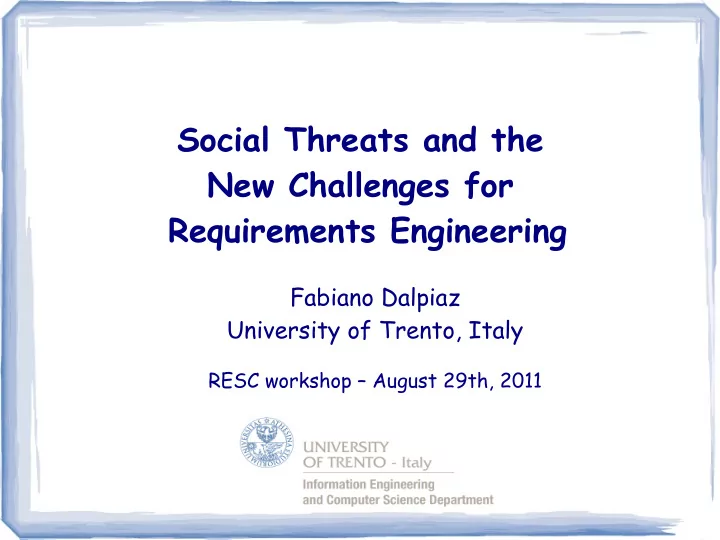

Social Threats and the New Challenges for Requirements Engineering Fabiano Dalpiaz University of Trento, Italy RESC workshop – August 29th, 2011
Outline Social computing: a viewpoint The new wave of social threats New challenges for Requirements Engineering F. Dalpiaz 2
Social computing: a viewpoint F. Dalpiaz 3
The social layer Computing heavily relies on technical layers – To simplify the engineering of complex computing artefacts – e.g. network stacks, architectures People use computing artefacts to interact with other people – A social layer virtually exists on top of technical layers! – However, such layer is not part of current computing paradigms F. Dalpiaz 4
The social layer exemplified Jim places a bid in an eBay auction HTTP request/ HTTP request/ response response Jim's PC eBay server Auctioneer's PC Technical layer I will pay 10€ for the book you are selling on eBay (auction ID xyz) Auctioneer Jim Social layer F. Dalpiaz 5
Social computing We understand social computing as a computing paradigm founded upon the social layer Social computing is conceived in terms of social primitives – Roles, agents, and commitments – Trust and reputation – Identity Example: Agent Jim playing role buyer takes the commitment to sell a book by Mark, playing seller, only if Jim trusts Mark and has proofs of the authenticity of the seller's website F. Dalpiaz 6
The new wave of social threats F. Dalpiaz 7
Social threats Technical threats affect technical layers – By exploiting vulnerabilities: DDoS, virus & worms, etc. On the other hand, social threats – Affect social relationships and artefacts – Are enacted via social mechanisms Many social threats are not new, but they will become of utmost importance with the advent of social computing! F. Dalpiaz 8
Social threats (1) Name Affects Example Jim rates Mike as a bad seller even if Mike T1. Fake reporting Reputation has delivered the goods on time Jim is waiting for some service to be T2. Decreasing Reputation delivered by Mike; however, Mike's reputation reputation is becoming lower and lower Mike offers a service to the general public. Jim decides to take such service; however, T3. Lack of trust Interaction since Mike does not trust Jim, he does not want to interact with Jim F. Dalpiaz 9
Social threats (2) Name Affects Example Jim delegates some service to Mike; Mike T4. Untrusted Trust delegates such service to Laura. Jim does delegation not trust Laura Jim relies on Mike and Tony for the T5. Dissolved Reliability redundant delivery of a service. Both Mike redundancy and Tony delegate the task to Laura. Mike deploys a service that complies with privacy laws. However, stricter laws are T6. Incompatible laws Compliance introduced and, now, the service is not compliant anymore F. Dalpiaz 10
New challenges for RE F. Dalpiaz 11
New challenges for RE Requirements Engineering (RE) is about eliciting, analysing, and specifying requirements for (software) artefacts Which are the artefacts these threats introduce? – Engineering requirements for these artefacts will be the challenge! – These challenges are not only for RE, but also for later stages in Software Engineering F. Dalpiaz 12
Challenges for RE (1) Addressed Challenge Description threats Robust mechanisms to compute Trustworthiness T1, T2 trustworthiness of actors based on management systems opinions by peers, compliance, certificates. Represent the commitments the provider Service interface makes to the consumer while ensuring specification and T4, T5 flexible negotiation, access control monitoring policies, accountability, compensation rules F. Dalpiaz 13
Challenges for RE (2) Addressed Challenge Description threats Logically distributed adaptation, from the Adaptation perspective of a single agent; social T2, T5 mechanisms threats trigger adaptation; incremental planning to deal with volatility Enable software to prevent bad events Early warning and T2 (e.g. via risk assessment) and switch to a response mechanisms different configuration F. Dalpiaz 14
Challenges for RE (3) Addressed Challenge Description threats Software shall be able to understand and Law representation check compliance with laws (e.g. data T6 and compliance confidentiality restrictions). Also, enforcement is a hot topic Develop robust identity management Identity management T1, T3 systems so unequivocally bind software systems systems to an accoutable legal entity F. Dalpiaz 15
Conclusions Social computing is centred around the social layer – The social layer captures the business meaning of computing Social threats will be pervasive – We presented/reviewed some of them These threats originate new challenges for RE – Resulting in new artefacts to design F. Dalpiaz 16
Thank you! dalpiaz@disi.unitn.it Thanks to John Mylopoulos, Paolo Giorgini, Amit K. Chopra, and Raian Ali for the useful discussions This research is sponsored by the European Community's Seventh Framework Program under grant agreement no. 257930 F. Dalpiaz 17
Recommend
More recommend